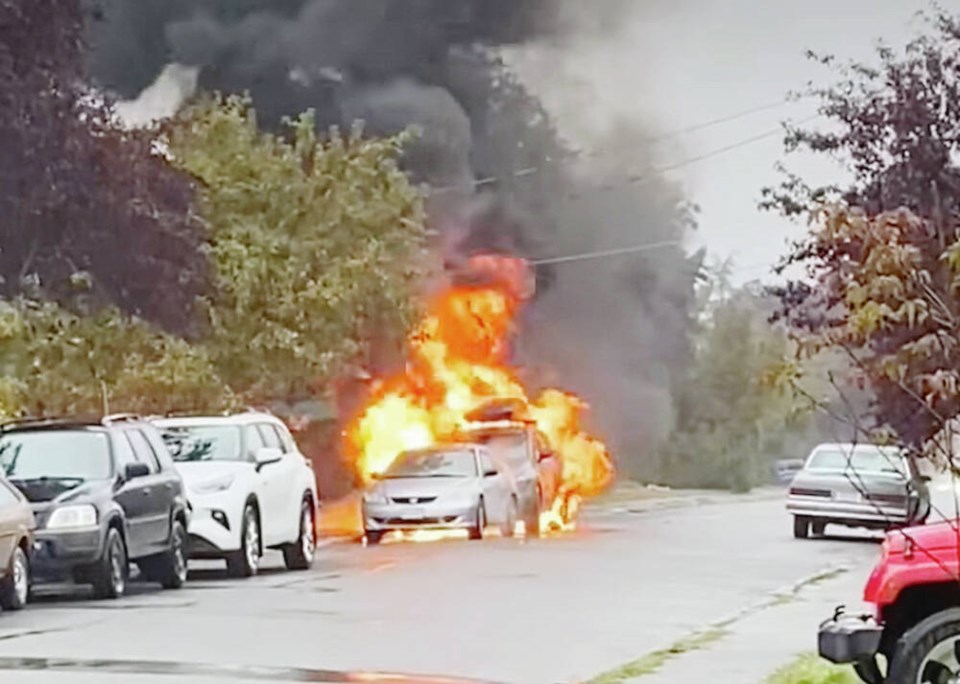Once again we’re thinking about the ravages of fire sweeping through our province this summer and with good reason. However, it made me also think about the dangers of fires starting in our own vehicles.
Modern technology has dramatically reduced the chances of your vehicle catching alight, yet island firefighters still respond to scores of vehicle Car-B-Qs every year.
About 10,000 vehicle fires occur every year in sa国际传媒 but most of those involve acts of arson, collisions, failing to properly fix defects and illegal modifications. About 100 fires occur as a result of manufacturing defects.
Electric vehicles are presenting new challenges to fire crews because of what is called sustained combustion. The makeup of new high-powered batteries are difficult to extinguish and have been known to burn for hours despite suppression efforts. Fortunately, according to U.S. insurance sources, electric vehicles catch fire far less frequently than their internal combustion counterparts — around 25 fires for every 100,000 vehicles sold.
Over half of all vehicle fires start in the engine. There can be many reasons for an engine fire but the primary one is a defective or improperly maintained piece of equipment in the fuel system. Gas leaking onto a hot engine means it’s only a matter of time before it ignites.
Just over 10% of car fires start in the interior of the vehicle. This is usually about improperly discarded smoking material. But in some unusual cases car fires have started because glass or plastic objects left exposed in the heat of the day, focusing the sun’s rays onto interior fabric or other material.
Catalytic converters can also be a culprit. I’ve seen several grass fires started underneath vehicles because the heat coming from a converter is more than sufficient to ignite dry tinder below it.
If you start smelling smoke as you are driving, that’s not the time to worry about what might be the cause. A car fire isn’t going to remain small for long. So pull over immediately and turn the vehicle off.
Turning the ignition off stops the flow of fuel to the engine of gas-powered vehicles. With electric vehicles, shutting down stops the power train and all accessories from working.
Get out of your vehicle as quickly as possibly. Be aware of your surroundings especially on busy fast moving highways. People who have escaped car crashes or vehicle fires are often struck by other passing vehicles because they lose awareness of the general environment they’ve escaped into.
Also remember it’s not just the flames you want to avoid. Smoke from a vehicle fire is full of toxic chemicals from the materials found in today’s vehicles. Move in a direction away from drifting smoke.
Fire experts recommend being at least 30 to 40 metres away from your vehicle if it’s burning. Move well off the roadway, ensure you and your passengers are safe and accounted for before calling 9-1-1.
Carrying a fire extinguisher in your vehicle is a good idea. But don’t just grab any old extinguisher from the big box store. Consult with a professional in the fire extinguisher business about exactly what type of unit is best for car fires. Cars are now full of every type of manufactured material under the sun. A fire extinguisher which is good for dousing the family campfire may be useless in combating a burning vehicle. Make sure you’re buying a CSA approved unit and inspect it frequently, ensuring it’s fully charged.
Finally, only attack a car fire with an extinguisher if you have to. There might be someone trapped in the car or there is a really good reason to try to put the flames out. Make sure you have clear access to the fire source and always have an escape route.
Many experts advocate for not opening the hood for risk of providing the fire source more oxygen. Most times you’re best off to move away and give first responders detailed information about the incident and your exact location.
Prevention as always is the key. Keep your vehicle maintained. Be aware of where you park and are placing that ultra hot catalytic converter under your car. Only carry flammable liquids in an approved container and only in small amounts. Follow manufacturer rules about recharging your EV. Never use a household extension cord to connect a level 1 EV cord to a household extension cord or multiplug adapter.
Always investigate burning smells inside your car right away. Awareness of how vehicle fires start and knowing what to do in advance if flames break out, are the most important steps you can take around vehicle fires.



